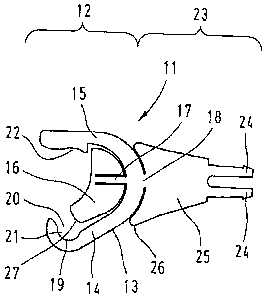Some of the information on this Web page has been provided by external sources. The Government of Canada is not responsible for the accuracy, reliability or currency of the information supplied by external sources. Users wishing to rely upon this information should consult directly with the source of the information. Content provided by external sources is not subject to official languages, privacy and accessibility requirements.
Any discrepancies in the text and image of the Claims and Abstract are due to differing posting times. Text of the Claims and Abstract are posted:
| (12) Patent: | (11) CA 2668604 |
|---|---|
| (54) English Title: | INTERLOCKING DEVICE FOR PLUG CONNECTOR HOUSINGS |
| (54) French Title: | DISPOSITIF DE VERROUILLAGE POUR COQUES DE CONNECTEURS MALES |
| Status: | Expired and beyond the Period of Reversal |
| (51) International Patent Classification (IPC): |
|
|---|---|
| (72) Inventors : |
|
| (73) Owners : |
|
| (71) Applicants : |
|
| (74) Agent: | BORDEN LADNER GERVAIS LLP |
| (74) Associate agent: | |
| (45) Issued: | 2012-01-10 |
| (22) Filed Date: | 2009-06-10 |
| (41) Open to Public Inspection: | 2009-12-13 |
| Examination requested: | 2009-06-10 |
| Availability of licence: | N/A |
| Dedicated to the Public: | N/A |
| (25) Language of filing: | English |
| Patent Cooperation Treaty (PCT): | No |
|---|
| (30) Application Priority Data: | ||||||
|---|---|---|---|---|---|---|
|
The invention proposes an interlocking device (10) for a two-part plug connector housing (3, 6) that is composed of two punched and bent one-piece interlocking elements (11) in connection with an exchangeable actuating handle (30). In this case, the interlocking elements (11) feature a clip-on side (23), by means of which they are engaged in the actuating handle (30), and an inter-- locking side (12) that is realized in the form of a C-shaped spring element (13), rotatably mountable on a pivot pin (4) of the lower plug connector housing half (3) and can be interlocked with a locking pin (7) of the upper plug connector housing half (6).
La présente invention vise à proposer un dispositif de verrouillage (10) pour une coque de connecteur mâle en deux parties (3, 6) qui se compose de deux éléments de verrouillage perforés et coudés (11) raccordés à une poignée de commande échangeable (30). Dans le présent cas, les éléments de verrouillage (11) comporte un côté pince (23), par lequel ils sont solidarisés avec la poignée de commande (30), et un côté de verrouillage (12) qui est réalisé sous la forme d'un élément à ressort en C (13), pouvant être monté de manière rotative sur une charnière à pivot (4) de la moitié de la coque du logement du connecteur mâle (3) et peut être verrouillé à l'aide d'une goupille de verrouillage (7) de la coquille supérieure du connecteur mâle (6).
Note: Claims are shown in the official language in which they were submitted.
Note: Descriptions are shown in the official language in which they were submitted.

2024-08-01:As part of the Next Generation Patents (NGP) transition, the Canadian Patents Database (CPD) now contains a more detailed Event History, which replicates the Event Log of our new back-office solution.
Please note that "Inactive:" events refers to events no longer in use in our new back-office solution.
For a clearer understanding of the status of the application/patent presented on this page, the site Disclaimer , as well as the definitions for Patent , Event History , Maintenance Fee and Payment History should be consulted.
| Description | Date |
|---|---|
| Time Limit for Reversal Expired | 2013-06-11 |
| Letter Sent | 2013-06-10 |
| Letter Sent | 2012-06-11 |
| Grant by Issuance | 2012-01-10 |
| Inactive: Cover page published | 2012-01-09 |
| Inactive: Final fee received | 2011-10-21 |
| Pre-grant | 2011-10-21 |
| Notice of Allowance is Issued | 2011-04-29 |
| Letter Sent | 2011-04-29 |
| Notice of Allowance is Issued | 2011-04-29 |
| Inactive: Approved for allowance (AFA) | 2011-04-21 |
| Amendment Received - Voluntary Amendment | 2011-02-07 |
| Inactive: S.30(2) Rules - Examiner requisition | 2010-12-16 |
| Inactive: Cover page published | 2009-12-13 |
| Application Published (Open to Public Inspection) | 2009-12-13 |
| Inactive: IPC assigned | 2009-11-09 |
| Inactive: First IPC assigned | 2009-11-09 |
| Inactive: IPC assigned | 2009-11-09 |
| Inactive: Filing certificate - RFE (English) | 2009-06-30 |
| Letter Sent | 2009-06-30 |
| Application Received - Regular National | 2009-06-30 |
| Request for Examination Requirements Determined Compliant | 2009-06-10 |
| All Requirements for Examination Determined Compliant | 2009-06-10 |
There is no abandonment history.
The last payment was received on 2011-04-05
Note : If the full payment has not been received on or before the date indicated, a further fee may be required which may be one of the following
Patent fees are adjusted on the 1st of January every year. The amounts above are the current amounts if received by December 31 of the current year.
Please refer to the CIPO
Patent Fees
web page to see all current fee amounts.
| Fee Type | Anniversary Year | Due Date | Paid Date |
|---|---|---|---|
| Request for examination - standard | 2009-06-10 | ||
| Application fee - standard | 2009-06-10 | ||
| MF (application, 2nd anniv.) - standard | 02 | 2011-06-10 | 2011-04-05 |
| Final fee - standard | 2011-10-21 |
Note: Records showing the ownership history in alphabetical order.
| Current Owners on Record |
|---|
| HARTING ELECTRIC GMBH & CO. KG |
| Past Owners on Record |
|---|
| ALBERT FERDERER |
| STEFAN SCHNIEDER |